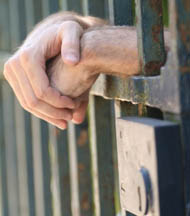Choosing the right measures of crime and justice requires an ongoing, open dialogue that considers both what the American people want to know and what experts consider most important for them to know.
As a starting point, State of the USA asked noted criminologist Henry H. Brownstein to compile draft a set of indicators for discussion and debate on the road to determining what's key. Public participation in this dialogue is strongly encouraged, in keeping with State of the USA's commitment to openness, inclusiveness and transparency.

Brownstein serves as senior vice president and director of Substance Abuse, Mental Health and Criminal Justice Studies at National Opinion Research Center. (More on Brownstein from NORC). He organized his suggested measures in an eight-category framework for thinking about them as a coherent set.
What crime and justice measures do you consider "key? Help shape progress in crime and justice with your ratings and comments below:
A Fluid List
"Crime delimits the boundaries of acceptable social behavior and criminal justice is a measure of our response to those who cross these socially defined boundaries," said Brownstein,
What's important to track in any given period is subject to change, he added, as society and the nature of crime and justice change.
For example, cybercrime may not have been high on everyone's list a decade ago, and ways to adequately measure it are still evolving.
"As society changes, the meaning and measure of crime and criminal justice change as well," Brownstein said. "Indicators, measures and statistics about crime, victimization and the processing of crime through the criminal justice system track what is happening and also how we place meaning and value on what is happening and how we respond to it. Over time, different types of crime become more or less important to us, as do our concerns about different issues related to crime and victimization.
"Some data and measures of crime, victimization and criminal justice are better or worse than others. Some are more timely than others," he added.
Selection Process, Audience Participation
The independent, nonprofit State of the USA works with the National Academy of Sciences to identify sets of "key" indicators in areas of civic concern, including crime and justice, following a formal selection process. (See our Editorial Policies).These focused, manageable sets -- out of hundreds of health indicators, 20 have been identified as "key" -- represent what leading subject-matter experts ultimately determine to be essential for tracking progress in a given issue area.
While awaiting the results of that formal process issue by issue, experts such as Brownstein help generate discussion and debate by sharing what they consider to be vital measures in their particular field of expertise, along with a framework for thinking about the issue as a whole. The State of the USA audience is encouraged to offer opinions and observations along the way, as well.
Choosing What to Measure WhenHistorically, Brownstein said, crime in the United States has been measured in terms of offenses known to the police - by the Uniform Crime Reports of the Federal Bureau of Investigation -- and victimization reported by survey respondents, using the National Crime Victimization Survey of the Bureau of Justice Statistics. "There is an extensive body of scholarly research comparing the two measures and considering the value and limits of each," he wrote. "Arguably, each represents something."
He added, "Criminal justice is measured as an accounting of the formal processing of criminal cases by law enforcement, courts and corrections agencies. Included are counts of things like arrests, court dispositions and sentences."
In closing, Brownstein cited a 1985 New York Times book review that captured the challenges of measurement. In "Lucking Into Harvard," a review of a book about how students are selected for admission to elite colleges in the U.S., reviewer David Nyberg wrote:
"The difficulty here (and for all of social science) is that we can't measure all the important things, so we make what we can measure more important than it is."
Howard Parnell is editor and vice president of content and creative for State of the USA,
 |
Victimizations |
Sample Measures and Sources: |
Violent Victimizations Sources: Firearm Victimizations Sources: Domestic Violence Sources: Victimization of Children (Abuse) Sources:
Victimization of Children (Neglect) Sources:
Elder Abuse Sources: |
 |
Street Crime |
Sample Measures and Sources: |
Total Crime Sources: Violent Crime Sources: Homicide Sources: Property Crime Sources: Gun Crime Sources: |
 |
White Collar Crime |
Sample Measures and Sources: |
Corporate Malfeasance Sources:
Cost of Consumer Fraud Sources:
Violations of Environmental Law Sources:
|
 |
Cybercrime |
Sample Measures and Sources: |
Use of Internet for Crime Sources: Identity Theft Sources:
|
 |
Criminal Justice Activity |
Sample Measures and Sources: |
Total Arrests Sources: Violent Crime Arrests Sources: Drug Crime Arrests Sources: White Collar Crime Arrests (Fraud) Sources: White Collar Crime Arrests (Embezzlement) Sources: Violent Crime Arrests Sources: Arrests by Gender Sources: Arrests by Race Sources: Prosecutions Sources: Convictions Sources: Incarceration: Extent in the U.S. Sources: Sentences to Incarceration Sources: Prison Inmates Sources: Jail Inmates Sources: Recidivism Sources:
|
 |
Special Populations |
Sample Measures and Sources: |
Homicide by Youth, Under 18 Sources: Homicide by Youth, Under 15 Sources: Youth in Youth Custody Sources: Gang Victimization Sources: Hate Crime Sources: |
 |
International Comparisons |
Sample Measures and Sources: |
Crime Comparisons Sources:
Arrest Comparisons Sources:
Homicide Comparisons Sources:
Incarceration Comparisons Sources:
|
 |
Public Safety |
Sample Measures and Sources: |
Fear of Crime Sources: Perception of Crime in Neighborhood Sources: Perception of Neighborhood Safety Sources: |
 Print This
Print This RSS Feed
RSS Feed